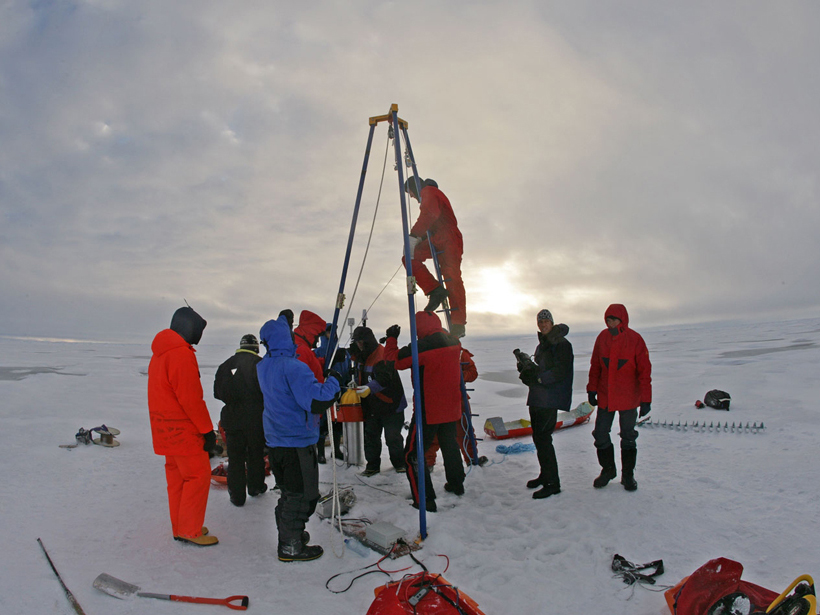As the warming Arctic rapidly transforms and its changes test the ingenuity and resources of scientists to understand them, Arctic nations are moving toward a legally binding agreement on scientific cooperation, negotiators said earlier this month at a panel discussion on Arctic research.
The pact could be ready for foreign ministers to sign at the spring 2017 ministerial meeting of the Arctic Council, an intergovernmental forum of eight Arctic nations that includes the United States, Russia, and Canada and 5 northern European states. That is according to Evan Bloom, director of the U.S. State Department’s Office of Oceans and Polar Affairs. Bloom is vice-chair, along with a Russian counterpart, of the Arctic Council’s Science Cooperation Task Force, which is working out the agreement. The United States will host the 2017 meeting at the conclusion of its current 2-year rotating term chairing the council.
Bloom made the first public presentation about progress on the multilateral Arctic agreement at the 15 January Stimson Center panel discussion. Under negotiation for several years already, the agreement will focus on details of improving research access and opportunities, he said.
Pact’s Possible Parameters
The agreement could cover the movement of people and scientific equipment, improving data sharing, access to facilities and research areas, and other issues, Bloom said.
The agreement could cover many important aspects of conducting Arctic research, which often extends beyond national borders, according to Bloom and other Arctic research experts. It could cover the movement of people and scientific equipment, improving data sharing, access to research infrastructure, facilities and research areas, advancing science education, protecting intellectual property rights, and other issues, Bloom said.
Panelist Jonathan White, rear admiral (retired), U.S. Navy, president and CEO of the Consortium for Ocean Leadership, suggested the agreement would provide guidelines for scientists from different nations to work together efficiently and effectively. He said that having such a pact “gives us the best possible optimistic outcome of a pristine, a peaceful, and a prosperous Arctic of the future without screwing it up.”

Something the pact won’t do is set international research priorities because several scientific bodies already help to coordinate that task, according to Kelly Falkner, director of the National Science Foundation’s Division of Polar Programs and head of the U.S. Delegation to the Science Cooperation Task Force. Because research priorities among Arctic nations overlap considerably and because nonpolitical bodies such as the International Arctic Science Committee already help to identify priorities, the task force concluded that “we should not be replicating those activities but rather focusing on our efforts on supporting and fortifying those activities,” Falkner said.
The task force decided instead that “we would focus on removing obstacles to Arctic science,” according to Bloom. He also noted that the agreement at this point would just be among the eight Arctic Council nations, but there is discussion about how to provide benefits to non-Arctic states. “There are many non-Arctic states that are very important to conducting Arctic research,” he explained.
Drive for a Deal
A variety of motivations and problems have propelled the quest for an agreement, panelists and other Arctic research experts said.
“In these times of change, I think the stakes for all of humanity in expanding our scientific knowledge of the Arctic are very high,” said Falkner. The United States already has bilateral science agreements with each of the other Arctic nations, she noted. This new multilateral agreement is important because the need to understand the pace and magnitude of change in the region extends beyond the resources of any single nation.
Panelist White noted that with new opportunities arising for resource extraction, shipping, and tourism in a rapidly changing Arctic, science can help governments, industry, and others understand and avoid risks and also can help provide “environmental security” in the region.
Past problems regarding scientific cooperation in the Arctic have also given some impetus to the negotiation. For instance, U.S. scientists at times have hit snags in obtaining permits to conduct research in some areas, geoscientist Julie Brigham-Grette of the University of Massachusetts Amherst told Eos. She serves as chairperson of the National Research Council’s Polar Board and was not on the panel. Given that an extensive part of the Arctic is in Russia, it is important to share information to more fully understand the Arctic and Arctic system science, Brigham-Grette said. The binding agreement will allow scientists to work together better and “open doors,” she noted.
Hurdles to Reaching an Agreement
Negotiators may have to work through some security concerns regarding the open data sharing aspect of the agreement, panelist David Michel told Eos. He is a nonresident fellow in the Stimson Center’s environmental security program.
Countries might balk at sharing charting information about areas around military facilities or exchanging data about ice thickness gathered by military submarines that might allow another party to determine the submarine’s capacities, he noted. Michel said other concerns include private parties wanting to retain proprietary information and the need to manage data that may have been collected in different formats in disparate circumstances. However, Michel said that parties to the agreement can probably work through many of these issues.
Ingredients for Success
“We’re not going to solve all of the problems of Arctic science cooperation in one moment, but this will help,” Bloom said.
In an interview with Eos, Bloom said he and others will judge the success of the eventual agreement by whether “it actually does provide a catalyst to removing obstacles” to Arctic research.
He hopes that it will. “We’re not going to solve all of the problems of Arctic science cooperation in one moment,” he said, “but this will help.”
—Randy Showstack, Staff Writer
Citation: Showstack, R. (2016), Arctic states nearing science cooperation pact, Eos, 97, doi:10.1029/2016EO044453. Published on 25 January 2016.
Text © 2016. The authors. CC BY-NC 3.0
Except where otherwise noted, images are subject to copyright. Any reuse without express permission from the copyright owner is prohibited.

